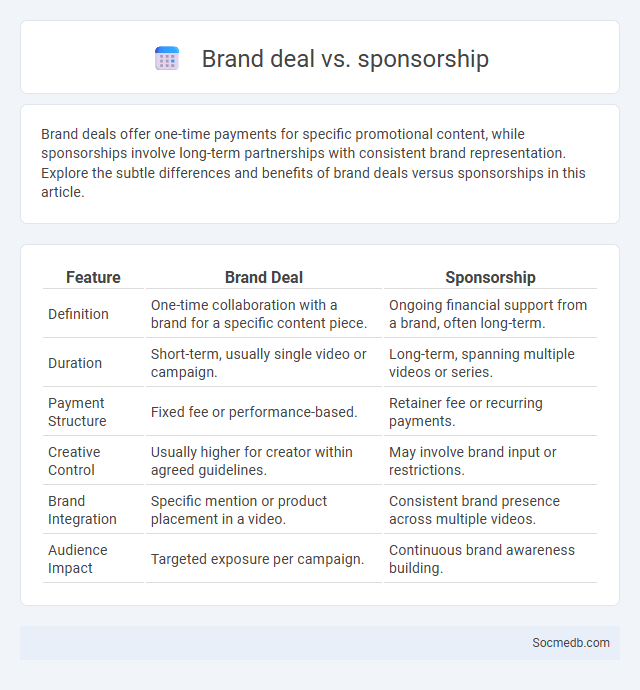
Photo illustration: Brand deal vs Sponsorship
Brand deals offer one-time payments for specific promotional content, while sponsorships involve long-term partnerships with consistent brand representation. Explore the subtle differences and benefits of brand deals versus sponsorships in this article.
Table of Comparison
| Feature | Brand Deal | Sponsorship |
|---|---|---|
| Definition | One-time collaboration with a brand for a specific content piece. | Ongoing financial support from a brand, often long-term. |
| Duration | Short-term, usually single video or campaign. | Long-term, spanning multiple videos or series. |
| Payment Structure | Fixed fee or performance-based. | Retainer fee or recurring payments. |
| Creative Control | Usually higher for creator within agreed guidelines. | May involve brand input or restrictions. |
| Brand Integration | Specific mention or product placement in a video. | Consistent brand presence across multiple videos. |
| Audience Impact | Targeted exposure per campaign. | Continuous brand awareness building. |
Understanding Brand Deals
Understanding brand deals on social media requires recognizing the value of audience engagement and platform reach, which directly influence a creator's partnership potential. These deals often involve sponsored content, product placements, or affiliate marketing agreements, where compensation varies based on follower metrics and content performance. Brands prioritize influencers with authentic connections to their niche, ensuring promotional messages resonate effectively with targeted demographics.
What Defines a Sponsorship?
A sponsorship is defined by a strategic partnership where a brand provides financial or in-kind support to an individual, event, or organization in exchange for advertising, promotion, or brand awareness opportunities. This relationship often includes explicit agreements on visibility, such as logo placement, shoutouts, or exclusive endorsements on social media platforms. Effective sponsorships leverage targeted audiences and measurable engagement metrics to maximize return on investment and brand loyalty.
Key Differences Between Brand Deals and Sponsorships
Brand deals usually involve a one-time payment or fixed fee for promoting a product or service on your social media channels, while sponsorships often include ongoing collaborations with a brand, delivering long-term partnership benefits. Sponsorships typically require a deeper relationship, encompassing multiple content pieces, exclusivity agreements, and sometimes product development input. Understanding these key differences helps you negotiate better terms and align your social media strategy with your personal or business goals.
Goals and Objectives: Brand Deals vs Sponsorships
Brand deals primarily aim to promote specific products or services within a short campaign, focusing on direct sales and instant engagement metrics like click-through rates or conversions. Sponsorships generally pursue long-term brand awareness and audience trust, leveraging consistent content integration and emotional connection over time. Clear objectives in brand deals emphasize measurable ROI and promotional reach, while sponsorships prioritize sustained audience loyalty and enhancing brand credibility.
Structure and Terms of Brand Deals
Social media brand deals typically involve structured contracts outlining deliverables, timelines, and compensation terms to ensure clear expectations between influencers and brands. Key contract components include content specifications, usage rights, confidentiality clauses, and performance metrics like engagement rates and impressions. Brands often leverage exclusivity agreements and FTC compliance requirements to maintain authenticity and legal adherence in sponsored content campaigns.
Structure and Terms of Sponsorships
Social media sponsorships are structured through clear agreements that define the roles, deliverables, and compensation between brands and content creators. Terms often include content guidelines, posting schedules, exclusivity clauses, and usage rights to ensure alignment with both parties' objectives. Precise contracts help manage expectations, legal compliance, and measurement of campaign effectiveness across platforms like Instagram, YouTube, and TikTok.
Content Control and Creative Freedom
Content control on social media platforms allows you to customize your audience and manage privacy settings effectively, ensuring your posts reach the right viewers. Creative freedom is enhanced through diverse tools and formats such as stories, reels, and live streams, enabling you to express your unique brand identity. Balancing content control with creative freedom empowers your online presence and fosters authentic engagement.
Measuring Success: ROI in Brand Deals vs Sponsorships
Measuring success in social media brand deals versus sponsorships hinges on evaluating return on investment (ROI) through key performance indicators like engagement rates, conversion metrics, and audience reach. Your ability to track direct sales, brand awareness, and follower growth provides crucial insights into which partnership yields higher value. Analyzing these data points helps optimize future marketing strategies and maximize your social media impact.
Choosing the Right Partnership for Your Brand
Selecting the right social media partnership involves aligning brand values with influencers or agencies that resonate with your target audience for maximum engagement. Prioritize collaborations with partners who demonstrate a proven track record in your industry, offering authentic content that drives meaningful interactions. Evaluating metrics such as audience demographics, engagement rates, and content quality ensures your brand voice is amplified effectively across platforms.
Future Trends in Brand Deals and Sponsorships
Emerging AI-driven analytics will revolutionize brand deals and sponsorships by providing deeper consumer insights for targeted campaigns on platforms like Instagram and TikTok. Influencer collaborations are evolving towards long-term partnerships with performance-based contracts to enhance authenticity and ROI. Virtual and augmented reality technologies are set to create immersive brand experiences, transforming traditional sponsorship models into interactive digital engagements.
 socmedb.com
socmedb.com